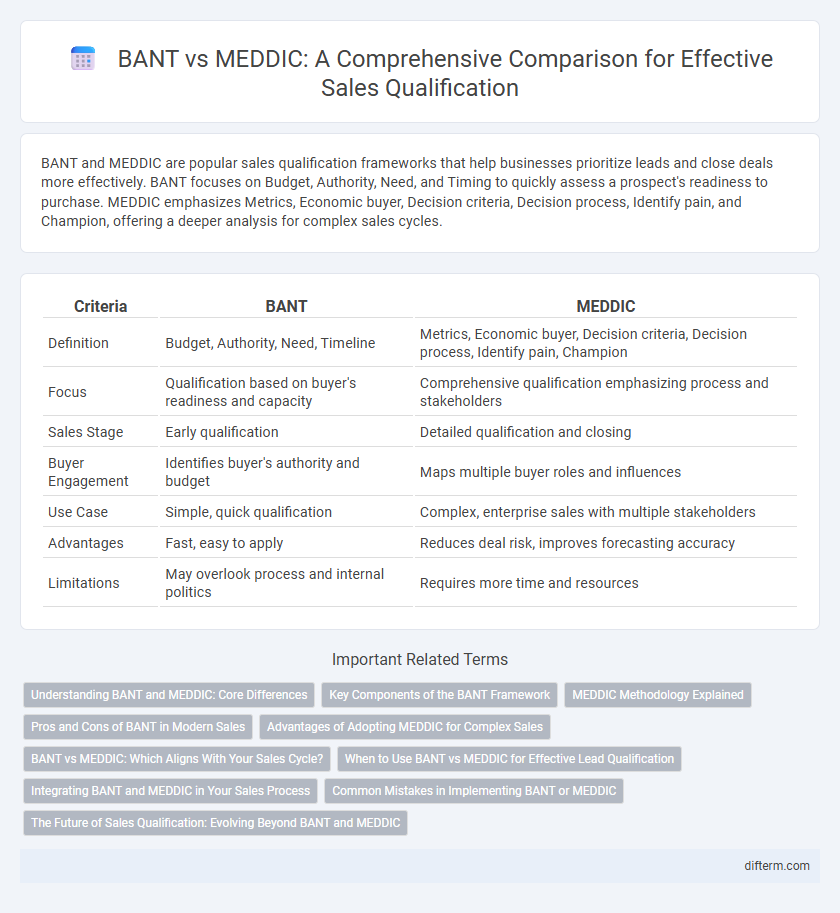BANT and MEDDIC are popular sales qualification frameworks that help businesses prioritize leads and close deals more effectively. BANT focuses on Budget, Authority, Need, and Timing to quickly assess a prospect's readiness to purchase. MEDDIC emphasizes Metrics, Economic buyer, Decision criteria, Decision process, Identify pain, and Champion, offering a deeper analysis for complex sales cycles.
Table of Comparison
| Criteria | BANT | MEDDIC |
|---|---|---|
| Definition | Budget, Authority, Need, Timeline | Metrics, Economic buyer, Decision criteria, Decision process, Identify pain, Champion |
| Focus | Qualification based on buyer's readiness and capacity | Comprehensive qualification emphasizing process and stakeholders |
| Sales Stage | Early qualification | Detailed qualification and closing |
| Buyer Engagement | Identifies buyer's authority and budget | Maps multiple buyer roles and influences |
| Use Case | Simple, quick qualification | Complex, enterprise sales with multiple stakeholders |
| Advantages | Fast, easy to apply | Reduces deal risk, improves forecasting accuracy |
| Limitations | May overlook process and internal politics | Requires more time and resources |
Understanding BANT and MEDDIC: Core Differences
BANT (Budget, Authority, Need, Timeline) focuses on qualifying prospects by assessing financial capacity, decision-making power, specific needs, and project timing, making it ideal for quick qualification. MEDDIC (Metrics, Economic Buyer, Decision Criteria, Decision Process, Identify Pain, Champion) offers a deeper, data-driven approach emphasizing detailed qualification steps and stakeholder engagement to optimize sales outcomes. The core difference lies in BANT's emphasis on initial qualification efficiency versus MEDDIC's comprehensive, strategic evaluation process for complex sales cycles.
Key Components of the BANT Framework
BANT framework consists of four key components: Budget, Authority, Need, and Timeline, which help sales teams qualify prospects effectively by assessing financial capacity, decision-making power, specific business needs, and purchasing schedule. Budget determines if the prospect has allocated funds, Authority identifies the decision-makers involved, Need evaluates the urgency and relevance of the solution, and Timeline sets the expected timeframe for purchase. This structured qualification process enables efficient resource allocation and improves sales conversion rates by targeting high-potential leads.
MEDDIC Methodology Explained
MEDDIC methodology emphasizes a detailed qualification process through Metrics, Economic Buyer, Decision Criteria, Decision Process, Identify Pain, and Champion to improve sales efficiency and accuracy. This approach helps sales teams align closely with customer needs and purchasing processes, leading to higher conversion rates and more predictable revenue outcomes. Compared to BANT, MEDDIC provides a deeper understanding of the buyer's context and internal decision-making dynamics in complex B2B sales environments.
Pros and Cons of BANT in Modern Sales
BANT (Budget, Authority, Need, Timing) offers a straightforward framework for qualifying prospects, enabling sales teams to quickly assess the viability of leads based on clear criteria. However, its focus on budget and authority can overlook deeper customer insights, limiting its effectiveness in complex or consultative sales processes prevalent in modern B2B environments. Compared to MEDDIC, which emphasizes detailed metrics and decision criteria, BANT may fall short in addressing nuanced buyer motivations and long sales cycles, potentially resulting in missed opportunities.
Advantages of Adopting MEDDIC for Complex Sales
MEDDIC excels in complex sales by providing a comprehensive framework that identifies Metrics, Economic buyer, Decision criteria, Decision process, Identify pain, and Champion, enabling deeper insight into customer needs and buying processes. This methodology enhances qualification accuracy, improves sales forecasting, and accelerates deal closure by aligning sales strategies with buyer priorities. Compared to BANT, MEDDIC's detailed approach supports navigating multiple stakeholders and intricate decision-making environments, making it ideal for enterprise-level sales.
BANT vs MEDDIC: Which Aligns With Your Sales Cycle?
BANT (Budget, Authority, Need, Timeline) emphasizes qualifying leads quickly by assessing financial readiness and decision-maker authority, ideal for shorter sales cycles. MEDDIC (Metrics, Economic Buyer, Decision Criteria, Decision Process, Identify Pain, Champion) provides a comprehensive framework suited for complex, enterprise-level sales with multiple stakeholders and longer decision timelines. Choosing between BANT and MEDDIC depends on your sales cycle length, deal complexity, and the depth of qualification needed to close effectively.
When to Use BANT vs MEDDIC for Effective Lead Qualification
BANT excels in early-stage lead qualification by assessing Budget, Authority, Need, and Timeline, making it ideal for quickly filtering prospects. MEDDIC offers a more comprehensive evaluation suited for complex sales, analyzing Metrics, Economic Buyer, Decision criteria, Decision process, Identify pain, and Champion to deepen understanding of business impact. Choosing BANT or MEDDIC depends on sales cycle complexity and deal size, where BANT streamlines initial screening and MEDDIC drives thorough opportunity qualification.
Integrating BANT and MEDDIC in Your Sales Process
Integrating BANT and MEDDIC in your sales process enhances qualification accuracy by combining Budget, Authority, Needs, and Timeline with Metrics, Economic Buyer, Decision criteria, Decision process, Identify pain, and Champion. This hybrid approach enables sales teams to identify high-potential leads, address customer pain points, and tailor proposals based on comprehensive insights into decision-makers and buying motivations. Leveraging both frameworks drives improved forecasting accuracy, shorter sales cycles, and higher close rates in complex business-to-business sales environments.
Common Mistakes in Implementing BANT or MEDDIC
Common mistakes in implementing BANT or MEDDIC include misidentifying budget limits and decision-maker roles, leading to inaccurate qualification of prospects. Over-reliance on one framework without adapting to specific sales cycles reduces effectiveness in complex deals. Failing to integrate both methodologies with CRM systems results in lost insights and missed revenue opportunities.
The Future of Sales Qualification: Evolving Beyond BANT and MEDDIC
Sales qualification is rapidly evolving beyond traditional frameworks like BANT and MEDDIC, driven by the need for more adaptive, data-driven, and personalized approaches. Emerging technologies such as AI-powered analytics and predictive modeling enable sales teams to identify high-potential leads with greater accuracy and efficiency. Future sales qualification frameworks will integrate real-time customer insights and contextual signals to optimize deal outcomes and accelerate revenue growth.
BANT vs MEDDIC Infographic

 difterm.com
difterm.com